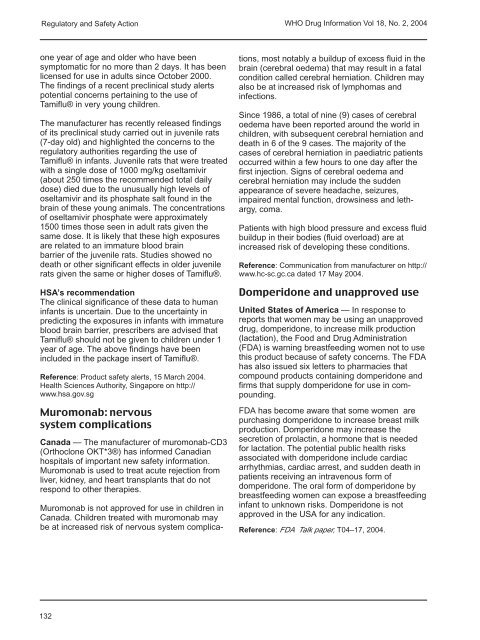WHO Drug Information Vol. 18, No. 2, 2004 - World Health ...
WHO Drug Information Vol. 18, No. 2, 2004 - World Health ...
WHO Drug Information Vol. 18, No. 2, 2004 - World Health ...
You also want an ePaper? Increase the reach of your titles
YUMPU automatically turns print PDFs into web optimized ePapers that Google loves.
Regulatory and Safety Action<br />
one year of age and older who have been<br />
symptomatic for no more than 2 days. It has been<br />
licensed for use in adults since October 2000.<br />
The findings of a recent preclinical study alerts<br />
potential concerns pertaining to the use of<br />
Tamiflu® in very young children.<br />
The manufacturer has recently released findings<br />
of its preclinical study carried out in juvenile rats<br />
(7-day old) and highlighted the concerns to the<br />
regulatory authorities regarding the use of<br />
Tamiflu® in infants. Juvenile rats that were treated<br />
with a single dose of 1000 mg/kg oseltamivir<br />
(about 250 times the recommended total daily<br />
dose) died due to the unusually high levels of<br />
oseltamivir and its phosphate salt found in the<br />
brain of these young animals. The concentrations<br />
of oseltamivir phosphate were approximately<br />
1500 times those seen in adult rats given the<br />
same dose. It is likely that these high exposures<br />
are related to an immature blood brain<br />
barrier of the juvenile rats. Studies showed no<br />
death or other significant effects in older juvenile<br />
rats given the same or higher doses of Tamiflu®.<br />
HSA’s recommendation<br />
The clinical significance of these data to human<br />
infants is uncertain. Due to the uncertainty in<br />
predicting the exposures in infants with immature<br />
blood brain barrier, prescribers are advised that<br />
Tamiflu® should not be given to children under 1<br />
year of age. The above findings have been<br />
included in the package insert of Tamiflu®.<br />
Reference: Product safety alerts, 15 March <strong>2004</strong>.<br />
<strong>Health</strong> Sciences Authority, Singapore on http://<br />
www.hsa.gov.sg<br />
Muromonab: nervous<br />
system complications<br />
Canada — The manufacturer of muromonab-CD3<br />
(Orthoclone OKT*3®) has informed Canadian<br />
hospitals of important new safety information.<br />
Muromonab is used to treat acute rejection from<br />
liver, kidney, and heart transplants that do not<br />
respond to other therapies.<br />
Muromonab is not approved for use in children in<br />
Canada. Children treated with muromonab may<br />
be at increased risk of nervous system complica-<br />
132<br />
<strong>WHO</strong> <strong>Drug</strong> <strong>Information</strong> <strong>Vol</strong> <strong>18</strong>, <strong>No</strong>. 2, <strong>2004</strong><br />
tions, most notably a buildup of excess fluid in the<br />
brain (cerebral oedema) that may result in a fatal<br />
condition called cerebral herniation. Children may<br />
also be at increased risk of lymphomas and<br />
infections.<br />
Since 1986, a total of nine (9) cases of cerebral<br />
oedema have been reported around the world in<br />
children, with subsequent cerebral herniation and<br />
death in 6 of the 9 cases. The majority of the<br />
cases of cerebral herniation in paediatric patients<br />
occurred within a few hours to one day after the<br />
first injection. Signs of cerebral oedema and<br />
cerebral herniation may include the sudden<br />
appearance of severe headache, seizures,<br />
impaired mental function, drowsiness and lethargy,<br />
coma.<br />
Patients with high blood pressure and excess fluid<br />
buildup in their bodies (fluid overload) are at<br />
increased risk of developing these conditions.<br />
Reference: Communication from manufacturer on http://<br />
www.hc-sc.gc.ca dated 17 May <strong>2004</strong>.<br />
Domperidone and unapproved use<br />
United States of America — In response to<br />
reports that women may be using an unapproved<br />
drug, domperidone, to increase milk production<br />
(lactation), the Food and <strong>Drug</strong> Administration<br />
(FDA) is warning breastfeeding women not to use<br />
this product because of safety concerns. The FDA<br />
has also issued six letters to pharmacies that<br />
compound products containing domperidone and<br />
firms that supply domperidone for use in compounding.<br />
FDA has become aware that some women are<br />
purchasing domperidone to increase breast milk<br />
production. Domperidone may increase the<br />
secretion of prolactin, a hormone that is needed<br />
for lactation. The potential public health risks<br />
associated with domperidone include cardiac<br />
arrhythmias, cardiac arrest, and sudden death in<br />
patients receiving an intravenous form of<br />
domperidone. The oral form of domperidone by<br />
breastfeeding women can expose a breastfeeding<br />
infant to unknown risks. Domperidone is not<br />
approved in the USA for any indication.<br />
Reference: FDA Talk paper, T04–17, <strong>2004</strong>.

















